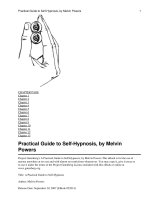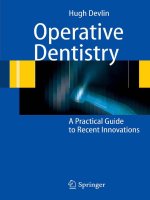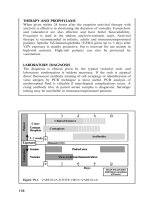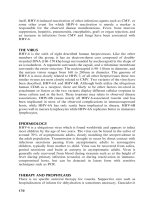The ADA practical guide to soft tissue oral disease edition 1
Bạn đang xem bản rút gọn của tài liệu. Xem và tải ngay bản đầy đủ của tài liệu tại đây (8.71 MB, 263 trang )
www.pdflobby.com
The ADA Practical Guide
to Soft Tissue Oral Disease
www.pdflobby.com
www.pdflobby.com
The ADA Practical
Guide to Soft Tissue
Oral Disease
Michael A. Kahn, DDS
Diplomate and Director, American Board of Oral and Maxillofacial Pathology
Professor and Chair, Department of Oral and Maxillofacial Pathology,
Oral Medicine, and Craniofacial Pain
Tufts University School of Dental Medicine
Boston, MA
J. Michael Hall, DDS
Diplomate, American Board of Oral and Maxillofacial Pathology
Associate Professor, Department of Oral and Maxillofacial Pathology,
Oral Medicine, and Craniofacial Pain
Tufts University School of Dental Medicine
Boston, MA
www.pdflobby.com
This edition first published 2014 © 2014 by John Wiley & Sons, Inc.
Editorial offices: 1606 Golden Aspen Drive, Suites 103 and 104, Ames, Iowa 50010, USA
The Atrium, Southern Gate, Chichester, West Sussex, PO19 8SQ, UK
9600 Garsington Road, Oxford, OX4 2DQ, UK
For details of our global editorial offices, for customer services and for information about how to apply
for permission to reuse the copyright material in this book please see our website at www.wiley.com/
wiley-blackwell.
Authorization to photocopy items for internal or personal use, or the internal or personal use of
specific clients, is granted by Blackwell Publishing, provided that the base fee is paid directly to the
Copyright Clearance Center, 222 Rosewood Drive, Danvers, MA 01923. For those organizations that
have been granted a photocopy license by CCC, a separate system of payments has been arranged. The
fee codes for users of the Transactional Reporting Service are ISBN-13: 978-1-1182-7797-3/2014.
Designations used by companies to distinguish their products are often claimed as trademarks. All
brand names and product names used in this book are trade names, service marks, trademarks or
registered trademarks of their respective owners. The publisher is not associated with any product or
vendor mentioned in this book.
The contents of this work are intended to further general scientific research, understanding, and
discussion only and are not intended and should not be relied upon as recommending or promoting a
specific method, diagnosis, or treatment by health science practitioners for any particular patient. The
publisher and the author make no representations or warranties with respect to the accuracy or
completeness of the contents of this work and specifically disclaim all warranties, including without
limitation any implied warranties of fitness for a particular purpose. In view of ongoing research,
equipment modifications, changes in governmental regulations, and the constant flow of information
relating to the use of medicines, equipment, and devices, the reader is urged to review and evaluate
the information provided in the package insert or instructions for each medicine, equipment, or device
for, among other things, any changes in the instructions or indication of usage and for added warnings
and precautions. Readers should consult with a specialist where appropriate. The fact that an
organization or Website is referred to in this work as a citation and/or a potential source of further
information does not mean that the author or the publisher endorses the information the organization
or Website may provide or recommendations it may make. Further, readers should be aware that
Internet Websites listed in this work may have changed or disappeared between when this work was
written and when it is read. No warranty may be created or extended by any promotional statements
for this work. Neither the publisher nor the author shall be liable for any damages arising herefrom.
Library of Congress Cataloging-in-Publication Data
Kahn, Michael A., author.
The ADA practical guide to soft tissue oral disease / Michael A. Kahn and J. Michael Hall.
1 online resource.
American Dental Association practical guide to soft tissue oral disease
Practical guide to soft tissue oral disease
Includes bibliographical references and index.
Description based on print version record and CIP data provided by publisher; resource not viewed.
ISBN 978-1-118-27798-0 (Adobe PDF) – ISBN 978-1-118-27800-0 (ePub) – ISBN 978-1-118-27797-3 (pbk.)
I. Hall, J. Michael, author. II. American Dental Association. III. Title. IV. Title: American Dental
Association practical guide to soft tissue oral disease. V. Title: Practical guide to soft tissue oral disease.
[DNLM: 1. Mouth Diseases. 2. Diagnosis, Oral. 3. Soft Tissue Neoplasms. WU 140]
RK307
617.5′22–dc23
2014001140
A catalogue record for this book is available from the British Library.
Wiley also publishes its books in a variety of electronic formats. Some content that appears in print
may not be available in electronic books.
Cover image: iStock/© Tjerrie
Cover design by Nicole Teut
Set in 9.5/12 pt PalatinoLTStd by Toppan Best-set Premedia Limited
1 2014
www.pdflobby.com
To our families and mentors for their support, patience, dedication, and lessons taught.
www.pdflobby.com
www.pdflobby.com
Contents
Preface
ix
Acknowledgment of a Career
xi
Acknowledgments
xiii
Section I Detection and Documentation
3
1. The Extraoral and Intraoral Soft Tissue Head and Neck Screening
Examination
5
2. Soft Tissue Head and Neck Pathology Description and Documentation
23
Section II Diagnosis and Management
35
3. Common Oral Soft Tissue Lesions
37
4. Differential Diagnosis of Common Oral Soft Tissue Lesions
113
5. Guidelines for Observation and/or Referral of Patients’ Lesions
127
6. The Art and Science of Biopsy and Cytology
133
Section III Clinicopathologic Exercises
143
7. Sample Patient Histories and Discussion
145
vii
www.pdflobby.com
viii Contents
Appendix A: Glossary of Descriptive Terminology
217
Appendix B: Formulary of Over-the-Counter and Prescription
Medications Based on Disease Classification; Common Errors
of Prescription Writing
221
Index
241
www.pdflobby.com
Preface
This textbook is intended to be a practical guide and reference source for the basic
clinical aspects of soft tissue oral and maxillofacial disease. It is not intended to be
an all-encompassing tome of oral pathology but rather to include those aspects of
this dental specialty that are its most important foundational information and the
most frequently encountered orofacial soft tissue diseases. The book is intended for
health-care practitioners whose occupation involves encountering a variety of conditions and diseases of the oral cavity and its contiguous anatomic structures; it is
not intended to be a reference source for oral medicine (i.e., details of the medical
aspects of a particular disease within the oral cavity).
We envision this book not as one to reside on a clinician’s library shelf gathering
dust and rarely referred to, but rather one used regularly within the dental operatory to help the clinician’s decision making: that is, deciding what is the best thing
to do for the patient when a pathologic condition is initially discovered, how
to determine its most likely provisional diagnosis or differential diagnosis,
whether to biopsy or refer for consultation by a dental or medical specialist, and
how to most accurately and effectively communicate that information to the patient
so the patient can give informed consent about his or her treatment course and
management.
Since 1984, when we began our residency training in oral pathology at Emory
University’s School of Dentistry (Atlanta, GA), we have increasingly recognized
specific essentials of oral pathology that need to be learned, understood, and used
by all dentists; furthermore, we have witnessed common diagnostic pitfalls and
management mistakes. This book is the culmination of our cumulative and collective experiential wisdom gained during our training as well as our subsequent
years of being in teaching institutions. By interacting with dentists, with dental and
dental hygiene students, and with physicians and patients in clinical and educational
ix
www.pdflobby.com
x Preface
settings as well as by participation in active oral pathology biopsy services and
clinical consultation clinics, we have become aware of the lesions commonly
encountered but misunderstood by them or unknown to them.
Michael A. Kahn
J. Michael Hall
www.pdflobby.com
Acknowledgment of a Career
I would like to recognize the many professionals who helped guide me in my quest
to find my niche in health care, first as a general dentist and then an oral pathologist. Anyone who has graduated from dental school can attest to its trials and tribulations and I was fortunate to have a “big brother,” Dr. Barry Kennedy, who as an
upperclassman helped guide me over the many hurdles encountered. One of the
Emory dental school faculty, Dr. Patricia Moultin, also offered words of encouragement when most needed to persevere and I am forever indebted to her. During my
early general dentistry career, in the U.S. Army, yet another individual, Dr. Jack
Edge (Lt. Col., retired), stepped up and taught me the “real-world” dental tricks of
the trade and guided me into correct and wise decisions. I decided to return to
Emory for my postgraduate training in oral pathology and am especially indebted
to my two primary mentors, Dr. D. R. (Ronnie) Weathers and Dr. Steven Budnick,
as well as two of my fellow residents, Dr. Craig Fowler and Dr. J. Michael Hall (the
coauthor of this textbook). Dr. John Kalmar, at that time a Young Dental Scientist
Award winner, also helped and taught me more than I can now remember. Following my stint at Emory, I did a one-year postdoctoral fellowship at Temple University, where Drs. J.C. Chen, Arthur (Art) Miller, and John Fantasia fine-tuned my
3-year postdoctoral training and helped my early transformation into a dedicated
faculty member. A seminal moment in my career occurred near the completion of
my fellowship when Dr. James Turner asked me to interview for an assistant professor position at UT–Memphis College of Dentistry. He took a chance on me and I
am forever grateful as he, Dr. Harry Mincer, and Dr. Marjorie Woods gave me every
opportunity to maximize my potential—I couldn’t have been luckier and I am
forever grateful. Soon after my arrival in Memphis I challenged the American Board
of Oral Pathology examination and I am indebted to the oral pathologists of the
AFIP, Dr. Fowler, and Dr. Robert Brannon for their willingness to share their education material and expertise. Approximately 11 years ago, my latest career phase began
when Dr. Robert (Bob) Goode strongly supported my move to Tufts University
xi
www.pdflobby.com
xii Acknowledgment of a Career
School of Dental Medicine. Bob was a wonderful mentor who served his country
admirably in the U.S. Air Force as an oral pathologist, including a stint as a forensic
odontologist. When our country experienced military mass disasters Bob was there
to provide closure to the families of the deceased. Unfortunately, poor health forced
Bob into early retirement. At Tufts, I learned much with Dr. Eleni Gagari, subsequently with Dr. Lynn Solomon, and most recently with Dr. Hall. A special tip of
the hat to Drs. Solomon and Hall for the extra workload they endured as I became
more and more active in organized dentistry, particularly within our specialty.
Finally, through all these years, the love and support of my deceased parents (Sylvia
and Leo) and my current nuclear family (Sandy, Greg, Matt, David), and most
especially the time they allowed me to be preoccupied with my professional duties,
is appreciated beyond description.
Michael A. Kahn, DDS
Tufts University School of Dental Medicine, Boston, MA
www.pdflobby.com
Acknowledgments
We are deeply indebted to the team at Wiley Blackwell who initiated contact with
us to consider this endeavor. First, to Ms. Shelby Allen, Associate Commissioning
Editor, whose vision and interest in our continuing education materials sparked a
potential interest to share its content with a wider audience of dental practitioners.
Subsequently, Ms. Melissa Wahl, Editorial Assistant, and Mr. Rick Blanchette, Commissioning Editor, Dentistry, helped guide us during the project’s development.
Lastly, Ms. Nancy Turner, Senior Development Editor, Heath Sciences, furnished
consistently excellent guidance, encouragement, wisdom, and assistance throughout.
At the American Dental Association (ADA) we thank Dr. Pamela Porembski,
DDS, Senior Manager, Council on Dental Practice, and Dr. Kathleen O’Laughlin,
DMD, Executive Director, for their belief in this endeavor, supplying support and
assistance, and working with many other members of the ADA to gain the project’s
acceptance and affiliation.
We also thank our colleagues at the various institutions we have worked at, as
they have shared their knowledge and teaching materials with us. In particular,
Drs. Goode, Solomon, and Gagari were involved in many of the materials used in
constructing the content of Chapter 7. In addition, we are very grateful to our colleagues throughout the world who have shared their unrestricted-use clinical
images with us at regional and national oral pathology meetings. We thank Heidi
Price for creating the original line drawings of Chapters 1 and 2.
Last, we thank our many patients and their clinicians who shared their patients
and/or their biopsied tissue with us and our students, whose pathology questions
spurred us to either respond from memory or seek additional references in order
to answer.
M.A.K.
J.M.H.
xiii
www.pdflobby.com
www.pdflobby.com
The ADA Practical Guide
to Soft Tissue Oral Disease
www.pdflobby.com
www.pdflobby.com
Section I
Detection and Documentation
www.pdflobby.com
www.pdflobby.com
1
The Extraoral and Intraoral Soft Tissue Head
and Neck Screening Examination
It is paramount that the dental clinician establish a repeatable, logical, sequentially
organized, and systematic approach to screening the soft tissues of the head and
neck region. It should be understood that this is not an “oral cancer screening,”
since all abnormal conditions should be detected. Performing an oral cancer screening means looking for a single condition, cancer, at a single point in time; the dental
clinician performs a complete exam, looking for all soft tissue abnormalities at a
single point in time. There is no universally acknowledged step-by-step approach;
therefore, the following is the one we adhere to and it can be modified as desired.
The important point is, whatever sequence is established, it should be strictly
adhered to each time to ensure that no step is omitted. A suggested ideal sequence
of steps for a complete oral mucosal screening procedure of a new patient includes
the following:
•
•
•
•
•
•
•
•
Introduction to the patient
Patient’s chief complaint
History of the present illness
Medical (including social) and dental histories
Physical examination (to detect the site, morphology, and color of abnormalities)
Review of data and formulation of a clinical differential diagnosis
Additional clinical and laboratory tests ordered, as indicated
Final definitive diagnosis with a treatment/management plan formulated
Certainly, the clinician should establish a pleasant rapport with the patient so
that excellent communication and trust are established. Often, the most critical or
The ADA Practical Guide to Soft Tissue Oral Disease, First Edition. Michael A. Kahn and J. Michael Hall.
© 2014 John Wiley & Sons, Inc. Published 2014 by John Wiley & Sons, Inc.
5
www.pdflobby.com
6 Detection and Documentation
important piece of information a patient possesses does not get transmitted to the
many forms filled out at the initial dental appointment. Once the patient’s trust,
confidence, and respect have been secured, the patient’s chief complaint must be
established. This can be a specific dental problem or a more generic goal such as “I
need a checkup exam.”
If the patient voices a specific reason for the dental appointment, it is very
important to gather as much subjective information from him or her as possible.
The collective sets of subjective information are the patient’s symptoms. Symptoms
include descriptions such as pain, burning, dry mouth, soreness, swelling, roughness, and paresthesia. Whatever the symptom, its specific nature should be questioned, such as onset, duration, periodicity, nature or character, severity, and
triggering factors or association. This information helps establish the history of the
present illness. The clinician gathers a pocketful of diagnostic clues provided by
the patient and combines them with the clinician’s pathology knowledge to guide
him or her to ask appropriate and insightful follow-up questions. Thus, the clinician
acts as a detective and must possess foundational knowledge of head and neck
disease and pathology in order to learn more about the patient and gather more
clues for the formulation of a well-honed clinical differential diagnosis. Subsequent
chapters of this book provide foundational knowledge—both general and specific—
of the most common soft tissue head and neck pathology.
Following determination of the history of the patient’s present illness, the
medical history is reviewed with the patient. Typically, the patient has previously
completed a detailed form providing the clinician with basic information about
childhood diseases; vaccinations; hospitalizations and prior surgeries; any current
medical care; date of the last physical examination; and medications (i.e., prescription and over-the-counter, including herbs) being taken or previously used, especially in the past 6 months. Details about the medications, including name, dosage,
and duration of use, are recorded. A complete review of systems (e.g., cardiovascular, pulmonary, renal, endocrine, nervous system) is performed to gather more
details than the initial “yes” or “no” responses. In addition, the medical history also
includes the patient’s psychological and socioeconomic profiles as well as social
habits (e.g., tobacco and alcohol abuse).
Next, the dental history, including details of any oral habits, is gathered. It is
important to note decayed, missing, and restored teeth as well as any active caries;
periodontal disease; history of extractions and other oral surgery procedures; tooth
vitality status; and any need for patient premedication. Any previous problems
during dental care are discovered and discussed. Oral habits include the patient’s
technique and frequency of flossing, brushing, use of mouthrinse, and occlusal
disharmonies.
Physical Examination
It is popular to compare the left and right side for bilateral symmetry while understanding that perfect symmetry is often not present within the range of normal. This is
particularly important in order to visualize enlarged lymph nodes or parotid glands.
www.pdflobby.com
Extraoral and Intraoral Screening Examination 7
Extraoral Sites
Specific sites include the following:
•
•
•
•
•
•
•
•
•
Hair and facial skin
External eyes
External ears
Temporomandibular joints
Facial muscles
Nasal vestibule
Thyroid gland (anterior neck)
Lymph nodes (lateral and posterior neck, supraclavicular notch)
Parotid gland
Assess the hair for thickness and loss; carefully examine the sun-exposed facial skin
for ultraviolet damage and lesion development, as well as the neck, ears, forehead,
nasal bridge and alae, malar region, eyebrows/eyelids/eyelashes, vermilion of the
lips, and the chin. Next, perform careful palpation of each of these sites to rule out
the presence of deeper, mesenchymal and other types of tissue swellings.
Palpate all lymph nodes and note any enlargement for additional testing since
normal lymph nodes are soft and not palpable (Fig. 1.1). Specifically, the subcutaneous tissue is digitally kneaded with a rotating motion in the areas of lymph nodes
based on the clinician’s knowledge of anatomy. This process can begin in the submental area, below and lingual to the chin, against the mylohyoid muscles. Next,
palpate the submandibular nodes by pressing the tissue below the jaw against
the medial side of the mandible or by bimanual palpation with one finger in the
mouth and the other externally pushing up. Next, palpate the parotid gland and
II
I
Sternocleidomastoid
Muscle
V
III
IV
Figure 1.1 Cervical lymph node levels.
www.pdflobby.com
Hyoid Bone
VI
Thyroid Cartilage
Cricothyroid Membrane
8 Detection and Documentation
its associated lymph nodes—look and feel anterior and posterior to the ear. Next,
palpate the cervical lymph node chain. The posterior cervical chain is along the
back of the neck, and the anterior and deep cervical chain is along the front. An
anatomical landmark for the latter nodes is the sternocleidomastoid muscle—trace
from behind the ear to the clavicle, kneading deep and medial to it. The postauricular and retrosternomastoid region should also be palpated along with the back of
the neck. Lastly, palpate the thyroid gland by placing fingers gently over it and
have the patient swallow. Sometimes, in order to discover an enlargement, the
grouped fingers are placed on one side of the larynx and pushed laterally while
palpating the opposite side.
Intraoral Sites
Specific mucosal covered sites include the following:
Oral cavity (Fig. 1.2a,b)
• Tuberosity/hamular notch
• Attached gingiva
• Retromolar pad/trigone area
• Vestibule (also called the mucobuccal fold)
• Buccal mucosa
• Labial mucosa
• Tongue (dorsal, ventral, and lateral surfaces)
• Floor of mouth
• Hard palate
• Submandibular and sublingual glands
Oropharynx (Fig. 1.3a,b)
• Soft palate
• Tonsillar pillars and fossa
• Tongue (base)
• Pharynx (lateral and posterior walls)
It is recommended that the same examination sequence be followed each time, first
by visual examination and then palpation. As mentioned previously, any sequence
can be used as long as it is organized and there is understanding of the findings
and the significance of deviations from normal. Palpation should be bimanual or
bidigital and, whenever possible, by direct vision. The following is a detailed suggested descriptive narrative:
1. Lips—Have the patient slightly part his or her lips to examine the upper and
lower vermilion borders and the left and right commissures. Then, with the
patient’s teeth occluded, evert both the upper and lower lips to expose the labial
mucosa. Observe the maxillary frenum, which at times may exhibit a mucosal
tag, a variation of normal. As the upper and lower labial mucosa become dry,
observe the minor salivary glands and attempt to express mucin from them.
www.pdflobby.com
Extraoral and Intraoral Screening Examination 9
(a)
Upper Labial Mucosa
Maxillary
Gingiva
Uvula
Hard Palate
Maxillary
Tuberosity
Soft Palate
Tonsil and Pillars
Retromolar
Pad
Hamulus
Mandibular
Gingiva
Mandibular
Vestibule
Lower Labial Mucosa
(b)
Hard Palate
Soft Palate
Pharyngeal Tonsil
Nasal Cavity
Upper Lip
Buccal Mucosa
Uvula
Palatine Tonsil
Anterior Two-Thirds
of the Tongue
Base of the Tongue
(Posterial One-Third)
Lingual Tonsil
Geniohyoid and Mylohyoid Muscles
Supporting the Floor of the Mouth
Figure 1.2 (a) Oral cavity proper, frontal view. (b) Major components forming the boundaries of the oral cavity proper, sagittal view. The oral cavity (unshaded area) is divided from the
oropharynx (shaded area) anteriorly/posteriorly at the posterior extent of the anterior two-thirds
of the tongue; the superior/inferior extent of the oral cavity is the hard palate and floor of
mouth; the superior/inferior extent of the oropharynx is the nasopharynx and hypopharynx.
While the lips are everted, the anterior maxillary and mandibular vestibules can
be observed.
2. Labial and buccal mucosa/alveolar mucosa and attached gingiva/trigone—Slide your
fingers posterior on the left and right buccal mucosa as well as the posterior
portion of the vestibules. The parotid papilla overlying Stensen’s duct should be
of normal coloration. To verify function, dry it, and then have the patient’s
www.pdflobby.com









